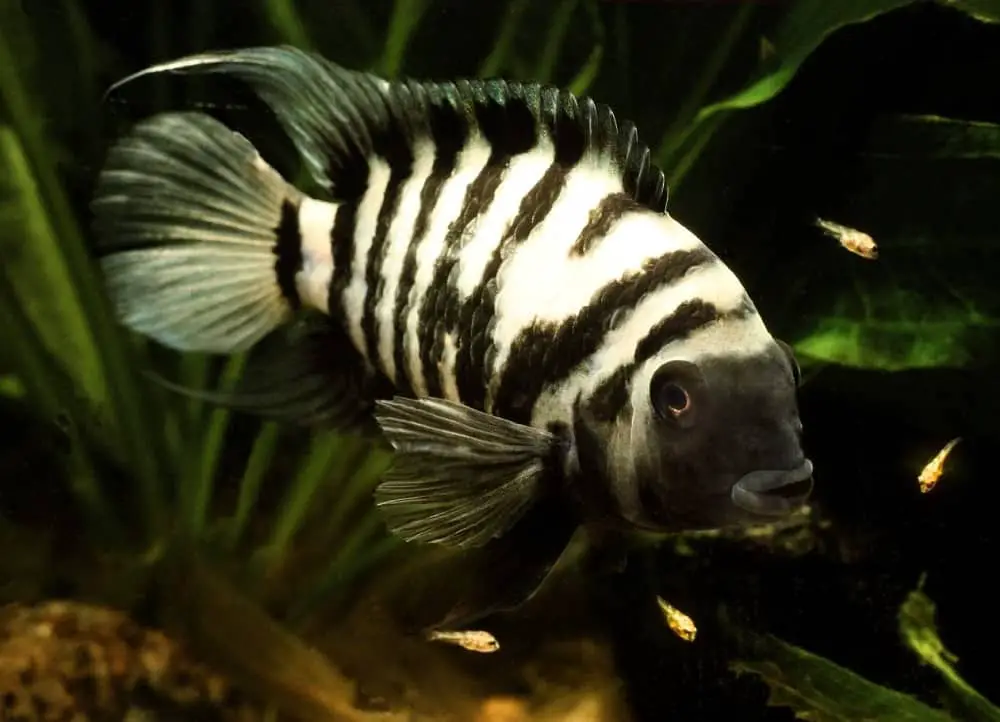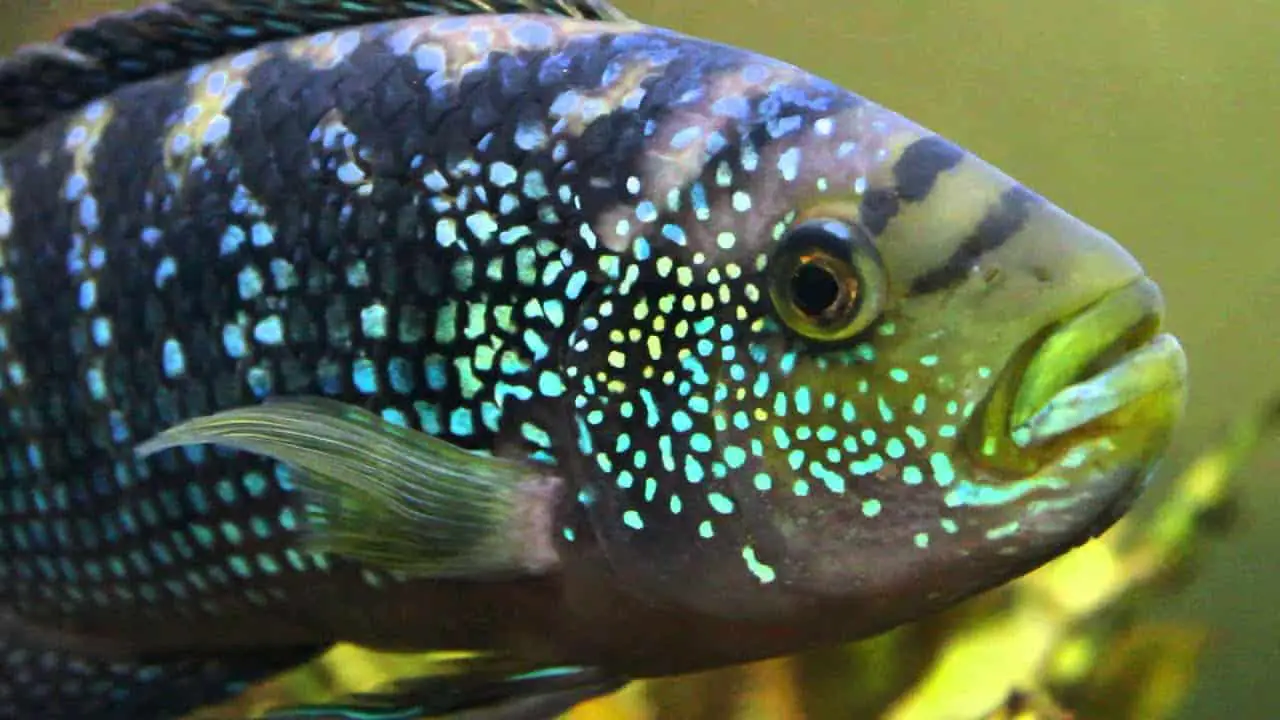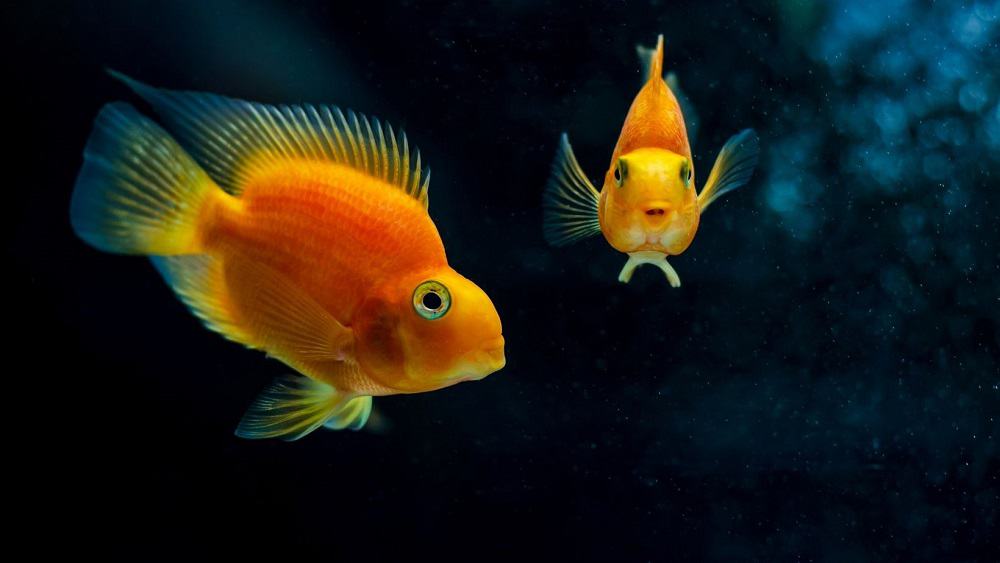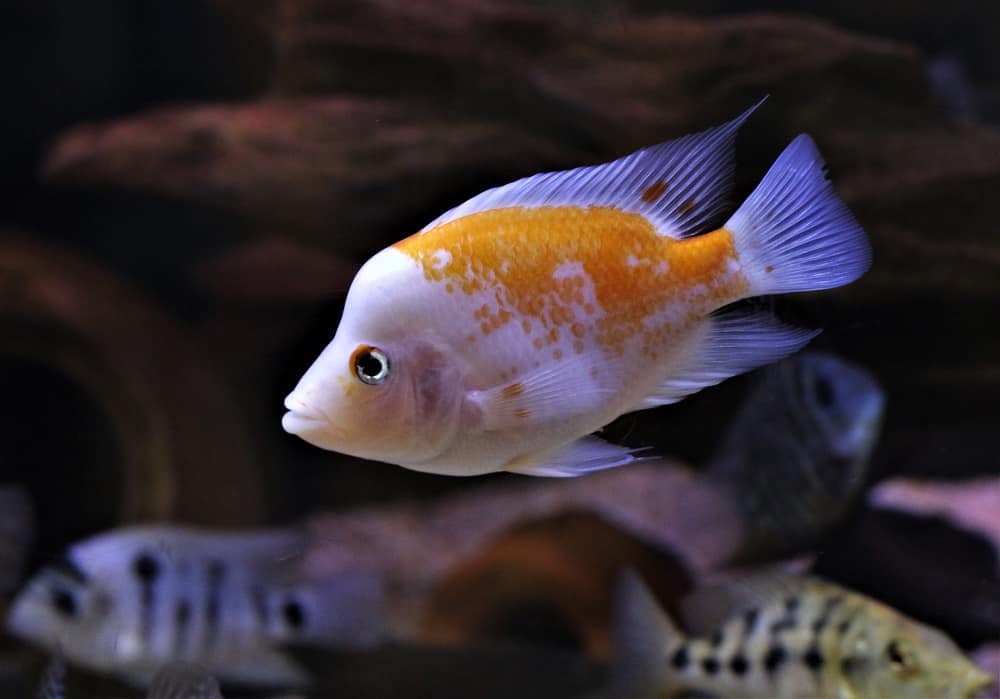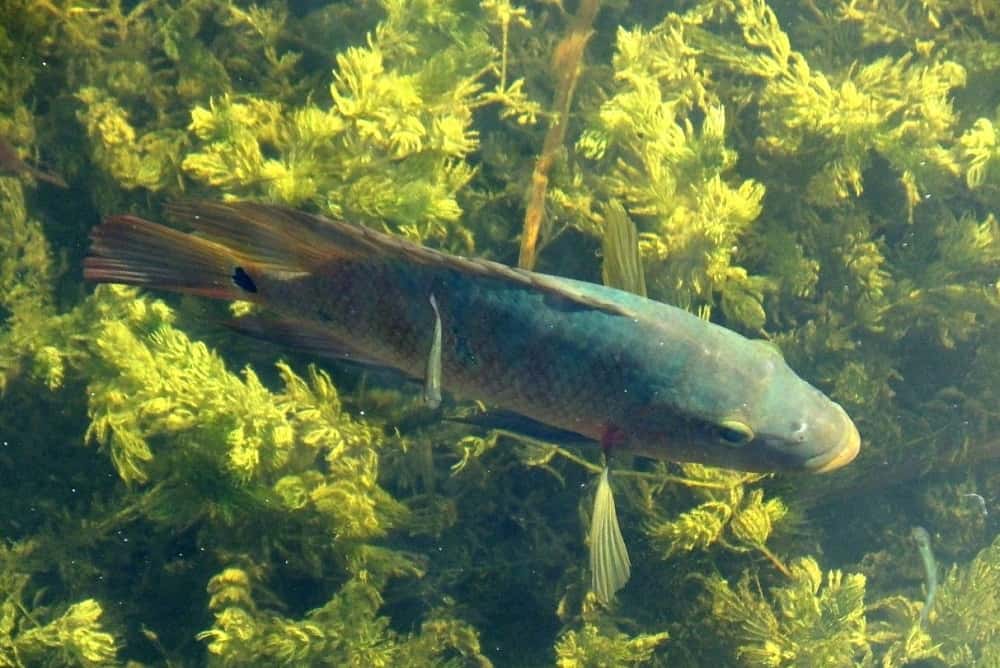A large fish with an incredible iridescent shine, the Texas cichlid has become a very popular choice for the home aquarium. Found in the freshwater of the Rio Grande in Texas, and in areas of northeast Mexico, they’re the only cichlid that’s native to North America.
They’re also a prolific invasive species, thanks to their violent attitude and willingness to eat whatever they can find. Sometimes fished for pleasure, in areas outside the Rio Grande the Texas cichlid should be removed if found in the water.
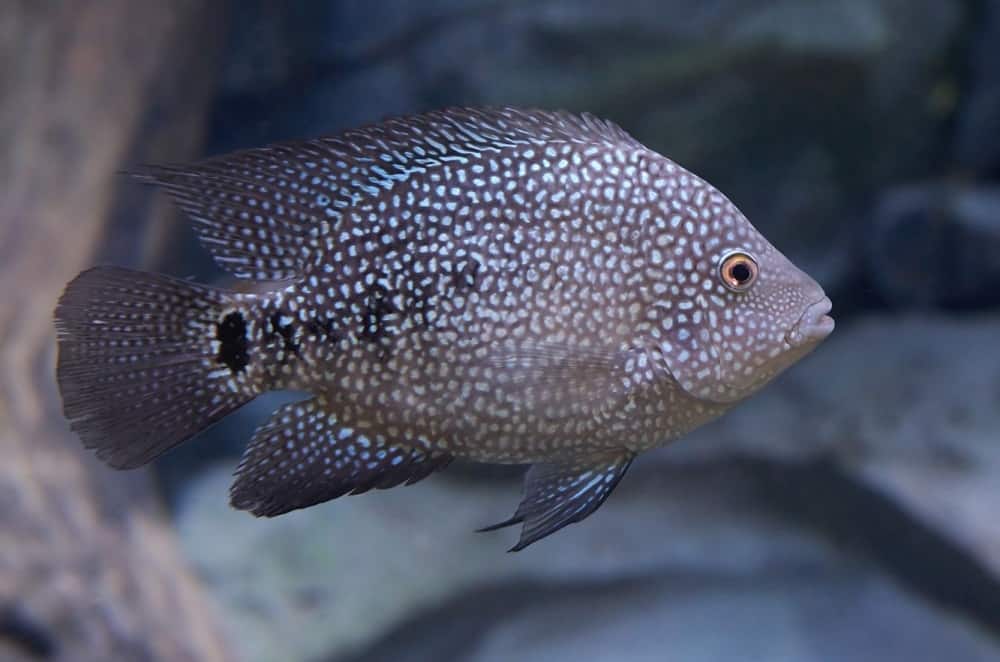
Known for aggressive behavior and an incredible appetite, the intelligent Texas cichlid can be a delight to observe. The Texas cichlid isn’t a difficult fish to look after – as long as you’re prepared for the attitude.
Tank mates are rarely welcome, and a carefully designed environment will not be appreciated. Nevertheless, the curious Texas Cichlid can bring hours of entertainment.
Care Guide
Tank Size
A 55 gallon tank is the minimum requirement for a Texas cichlid.
A large tank is needed to ensure your cichlid can grow to its full size. Bigger is definitely better, and 55 gallons should be considered the absolute minimum for a single fish.
A breeding pair may be comfortable in a 75 gallon tank, but 125 gallons is better for more than one fish. The Texas cichlid needs to establish territory, making the larger tank a necessity.
Tank Mates
In the wild, the Texas cichlid lives most of its life solitary. They’re aggressive fish, who will violently defend a territory. For this reason, they don’t make ideal tank mates. If you do want to put other fish with your Texas cichlid, they need to be large enough to defend themselves.
Other cichlids can be suitable, but watch out for territory disputes. Other fish to consider are Oscars, giant gouramis, silver dollars, or tinfoil barbs. Avoid anything too small or shy.
All Texas cichlids have their own unique personalities. Some will be happy to share a tank, while others won’t get on with any other fish at all.
Same Species Tanks
A same species tank is possible with the Texas cichlid, but they’re happier on their own. If you do want to establish a same species tank, it’s important to have enough space for each fish to mark out a place as their own.
Water Parameters
The Texas cichlid is found in the Rio Grande area of Texas, and the conditions in the tank need to imitate these water parameters. The temperature needs to be warm, between 68 and 75 F (20 to 24 C). The pH level should be within the range of 6.5 to 7.5, with a water hardness of 8 to 15 dGH.
It’s important to establish weekly partial water changes, to mimic the water flow of the natural environment.
What To Put In Their Tank
To imitate the natural environment of the Texas cichlid, a substrate of fine gravel or sand is needed. A mixture of both is best. Decorate with smooth rocks and driftwood. Plant life is also good, but be sure to get hardy plants and anchor the roots well. Floating plants can also work nicely.
Open spaces are vitally important, so that the Texas cichlid can swim happily. However, a few areas of cover are good. Use large stones and vegetation, so the cichlid can hide if it wants to.
If you enjoy creating intricate underwater landscapes, then the Texas cichlid is not the fish for you. It’s well known for digging, and will uproot any plant that isn’t firmly anchored. They’re also aggressive and have been known to pick at plants.
Common Diseases
A sturdy fish, there are few diseases that pose a particular threat to the Texas cichlid. However, they are still susceptible to diseases that affect all fish. Keep an eye out for fin rot. This can occur when a fish has sustained an injury. Be sure to remove any sharp rocks, and keep vegetation trimmed.
Food & Diet
The Texas Cichlid is omnivorous, and in the wild will eat vegetable matter, insects, and even small fish. In some situations, it will even feast on amphibians.
In the aquarium, a similar variety is needed. The Texas cichlid is not a fussy eater, and is known for being an opportunistic feeder. They should have a mixture of meaty foods and vegetation, but flakes and pellets can be used to supplement the diet.
A Texas cichlid will eat both frozen and live food, but it’s good to feed them live worms when possible. Fresh vegetation should also form part of the diet.
Overeating is common in the Texas cichlid. Feed them twice a day, with small portions.
Lifespan
With proper care, the Texas cichlid can have a lifespan of up to 13 years. If cared for correctly in an aquarium, expect to see your Texas cichlid live for over 10 years.
Appearance
The Texas cichlid is a very popular fish thanks to the incredible coloring. The adults have a golden shaded base color, covered in white and turquoise spots.
They have a pearl glow, which is particularly impressive when it catches the light. The back of the body is decorated with dark stripes, which turn to black when the fish is ready to breed.
The Texas cichlid has the classic body shape of the cichlid. Rounded, with large eyes and long fins, they’re a beautiful addition to the home.
Size
A large fish, the Texas cichlid can grow to be over 13 inches (33 cm). In a tank, they’re unlikely to reach this size. However, over 10 inches (25 cm) is to be expected.
Behavior & Temperament
The Texas cichlid is known for being an aggressive fish, particularly when guarding young. Both the male and female will fight other cichlids for breeding grounds, and attack any potential predators who come towards the young.
But this aggression continues even outside the breeding season. A solitary fish, aggression can be seen if they’re made to share a tank. Because of the aggressive nature, Texas cichlids aren’t recommended for first time fish owners.
Despite the attitude, the Texas cichlid is a lovely fish to own. They’re intelligent and inquisitive, and have been seen to recognize their owners. They can also learn when feeding time is, and will often head to the font of the tank when they think food is coming.
Breeding
Breeding the Texas cichlid is actually quite easy, although you do need to have a large tank. Breeding pairs often consist of a smaller female and a larger male, and the pairs are monogamous. A good way to get a breeding pair is to purchase several young Texas cichlids. They should naturally begin to pair off.
Once you have a breeding pair, they need to be separated into a different tank. The color of the fins will often darken, indicating when the pair is ready to breed. Their courtship routine is active, and involves fin slapping and quick movement – they even appear to kiss.
Lay a large flat rock in the tank, and provide the Texas cichlid with some areas to shelter. Before laying, the female nips at the ground to clean it. The female will then lay the eggs in batches, until somewhere between 500 and 1000 eggs have been laid. The male will follow behind, fertilizing the eggs.
After roughly 2 to 3 days, the eggs will hatch. By day 5, they should be free swimming. First time breeders may eat the young, but they will learn, and shouldn’t do it next time.
The breeding pair can be aggressive and territorial, which is why they need to be separated. However, sometimes the pair will turn aggressive towards each other. In this case, they may need to be kept apart.
In the wild, the Texas cichlid will travel long distances between March and August. Having found a place to breed, they guard it against any invaders. This behavior is often reflected in aquarium breeding.
Gender differences: Male vs Female
It is possible to tell the difference between a male and female Texas cichlid. The male is generally larger, and will often have a brighter colored patterning across the body.
The male fins have also been observed as longer and pointier. The female has a black spot on the dorsal fin, which isn’t present in the males.
Another clear way to distinguish the genders is the nuchal hump. This large bump on the head is found on the adult male Texas cichlid. However, they don’t all develop them. Some claim to have seen a nuchal hump on females as well.
Fun Facts
- The most northern occurring cichlid, and the only one native to the United States.
- The Texas cichlid is sometimes known as the Rio Grande cichlid, after the area it calls home.
- This fish loves to dig, and will happily uproot any plant life that isn’t well anchored in the substrate. This digging behavior can be frustrating for owners who enjoy curating an aquarium, but it’s just the cichlid having fun.

